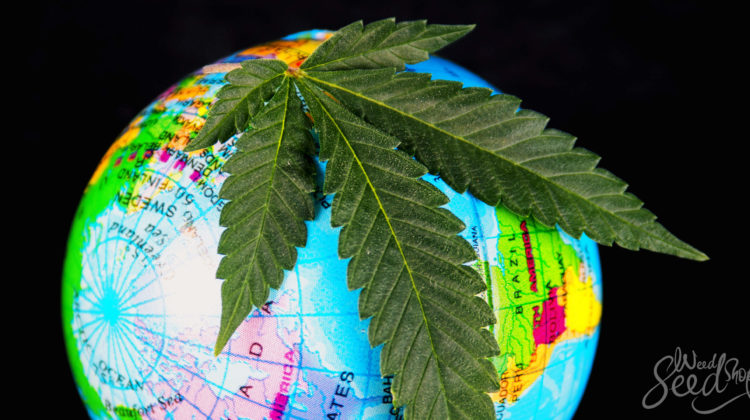
From ancient Egyptians, to Vikings, and into the modern day, humans have consumed cannabis to get high and as medicine since at least 500 B.C. One plant has traveled throughout the world with quite a fight as lawmakers try to prevent their citizens from roaming freely with cannabis. Now, that is changing. Here is a look into the history of cannabis and the roadblocks it encountered.
From the Beginning
Historians trace the first use of cannabis to Central Asia, reports History.
In these ancient times, people were drawn to cannabis for it’s healing power and seeds, and not so much for its high. However, they did know about the psychoactive effects of cannabis and may have bred plants high in THC to achieve a high, reports the National Institute of Drug Abuse.
In fact, the oldest evidence of burnt cannabis seeds were found in the graves of religious leaders and healers in China and Siberia around 500 B.C., according to Live Science.
However, hemp fibers were used to make clothes, rope, paper, and sails. As humans migrated and traveled the world through trade routes like the Silk Road, the plant went with them.
It traveled throughout Africa, Europe, and eventually to the Americas. Ancient Egyptians used cannabis as an anti-inflammatory, and to treat menstrual pains, glaucoma, and any type of pain.
Cannabis was used in burial ceremonies in Central Asia and Europe. Specifically, historians found traces of cannabis on the body and lungs of mummies. Thus implying Egyptians used cannabis for its medicinal value before their death, according to Green Entrepreneur.
Traveling to U.S.
When the first Jamestown settlers came to America in the 1600s, they brought hemp with them. It soon became an important American export, reports ProCon.org. When the Europeans first arrived in Jamestown, they struggled to grow food and stabilize the settlement until tobacco and cannabis became a popular export.
In early America, colonists were oftentimes required to grow and sell hemp. Our founding fathers, George Washington and Thomas Jefferson had their very own hemp farms.
Many used the plant in its different forms throughout the Western hemisphere. The U.S. Pharmacopeia listed cannabis as a treatment for numerous conditions.
It was not until the 20th century that officials started to criminalize cannabis in the U.S. due to political and racial factors, explains History.
Rise of Reefer Madness
The fear of cannabis was becoming more of an issue after the Mexican Revolution in 1910, states PBS. Mexican immigrants flooded the U.S., and introduced recreational cannabis to Americans. Lawmakers and high-ranking officials associated cannabis with Mexican immigrants and crime.
The Marihuana Tax Act of 1937 essentially halted the use of recreational cannabis and hemp, according to the U.S Customs and Border Protection Agency. Officials designed the act to tax the sale, possession, and transfer of all hemp products.
For example, officials taxed importers to $24 per year on cannabis shipments. Regulators held shipments in the ports of entry until traders provided them with proper paperwork. Oftentimes, shipments were eligible for searches and seizures. If people violated the law, they could be charged with up to a $2,000 fine and five years in prison.
Hemp for Victory to the War on Drugs
During World War Ⅱ, military supplies, including hemp, were scarce. So, The U.S Department of Agriculture launched it’s Hemp for Victory campaign. The campaign encouraged farmers to plant hemp. Officials also offered a draft deferment to those who stayed home and grew the plants instead of going to war, reports PBS.
After the war, U.S. officials passed the Narcotics Control Act of 1956, which imposed harsher sentencing on cannabis use and possession, PBS adds. For example, a first-time possession offense came with a minimum prison sentence of two-10 years with fines up to $20,000.
It was not until 1971 that President Richard Nixon officially declared the War on Drugs and included cannabis in the list of Controlled Substances, reports the Drug Policy Alliance. Nixon placed cannabis into the list of Schedule Ⅰ drugs, the most restrictive category. Officials do not consider substances in this category to have any medicinal properties.
With Nixon’s push, The Control Act of 1970 (which became effective in May 1971) is what officially made cannabis illegal for all purposes along with all Schedule Ⅰ drugs such as LSD, heroin, ecstasy, according to the Reuters legal resource, Findlaw.
Cannabis laws changed yet again once President Ronald Reagan was in office. Reagan signed the Anti-Drug Abuse Act that correlated with the Comprehensive Control Act, according to the Drug Policy Alliance. One act instituted mandatory sentencing to drug-related crimes and the other raised federal penalties for cannabis dealing and possession. Nancy Reagan, the first lady, advocated for the Drug Abuse Resistance Education (D.A.R.E) program at schools, which guided teenagers away from cannabis and all types of drugs. From that point, cannabis didn’t see much legal change after the 80s.
New Beginnings for the Cannabis Industry
It was not until 1996 that medical cannabis became legal in California. Dennis Peron, the father of medical cannabis, advocated the usage of medical cannabis and the legalization when his partner died of AIDS, explains Weedmaps. Peron is best known for his work on Proposition 215, which legalized medical cannabis in California.
A little over a decade later, Colorado and Washington became the first states in America to legalize recreational cannabis. Some states that shortly followed were Alaska, Oregon, California, and most recently, New York, New Mexico and Virginia. As of April 2021,18 states now allow their residents to possess recreational cannabis.
In addition to state-led legalization, the federal government has also started to legalize forms of the plants. For example, the 2018 U.S. farm bill legalized hemp nationwide. The U.S. Farm Bill enabled the production and selling of hemp with under 0.3% THC contained, explains the Brookings Institute.
Cannabis Today
Nearly 40 states, and counting, have legalized cannabis in some form or another. However, the plant (with the exception of hemp) remains federally illegal.
Interestingly, the U.S. Food and Drug Administration (FDA) approved of two pills containing THC, Marinol and Syndros. Both pills treat nausea associated with cancer treatments, and increase appetites in AIDS patients.
Patients can find medical cannabis just about anywhere throughout the world. Today, over 30 countries, not including the U.S., have medical cannabis legalized to some extent, reports The Motley Fool.
Currently only two countries, Canada and Uruguay, have legalized cannabis for both recreational and medical use. As public support increases, it will not be surprising that within the upcoming years cannabis will be legalized vastly throughout the world. Cannabis has been part of cultures for centuries, and it’s legacy will continue to grow.



Leave a Reply